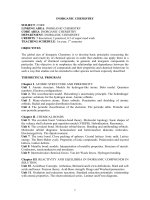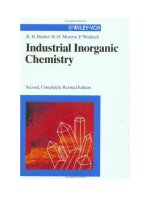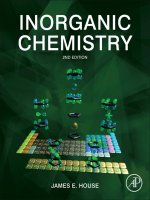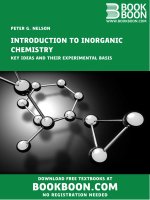Inorganic chemistry
Bạn đang xem bản rút gọn của tài liệu. Xem và tải ngay bản đầy đủ của tài liệu tại đây (41.36 MB, 1,677 trang )
INORGANIC CHEMISTRY
www.pdfgrip.com
ABOUT THE AUTHORS
Rajni Garg is working as Head, Department of Applied
Chemistry, RITM, Faridabad. She received her doctorate
degree in Chemistry from Gurukula Kangri University,
Haridwar, Uttar Pradesh, and postgraduate degree in
Chemistry (Honours) from Panjab University, Chandigarh.
She has more than 12 years of research and teaching
experience and has authored several national and
international publications.
Randhir Singh is working as Professor and Head in the
Department of Chemistry, Gurukula Kangri University,
Haridwar, Uttar Pradesh. He received his doctorate degree
in Chemistry from University of Roorkee, India (now IIT)
and postgraduate degree in Chemistry from University of
Meerut, India. He has been Postdoctoral Research Associate
in the Department of Biochemistry and Molecular Biology,
University of Southern California, Los Angeles, USA, and
visited University of Southern California, Los Angeles, as scientist exchange
programme. He has more than 35 years of research and teaching experience
and has guided many MSc, MPhil. and PhD students in their theses work. He
has received many academic honours from Council of Scientific and
Industrial Research, India, for his research contributions and has several
national and international publications.
www.pdfgrip.com
INORGANIC CHEMISTRY
Rajni Garg
Associate Professor and Head
Department of Applied Sciences
Rattan Institute of Technology
and Management Faridabad, Haryana
Randhir Singh
Professor and Head
Department of Chemistry
Gurukul Kangri Vishwavidyalaya
Haridwar, Uttar Pradesh
McGraw Hill Education (India) Private Limited
NEW DELHI
McGraw Hill Education Offices
New Delhi New York St Louis San Francisco Auckland Bogota Caracas Kuala
www.pdfgrip.com
Lumpur Lisbon London Madrid Mexico City Milan Montreal San Juan Santiago
Singapore Sydney Tokyo Toronto
www.pdfgrip.com
McGraw Hill Education (India) Private Limited
Published by McGraw Hill Education (India) Private Limited
P-24, Green Park Extension, New Delhi 110016
Inorganic Chemistry
Copyright © 2015 by McGraw Hill Education (India) Private Limited.
No part of this publication can be reproduced or distributed in any form or by any means, electronic,
mechanical, photocopying, recording, or otherwise or stored in a database or retrieval system without
the prior written permission of the publishers. The program listings (if any) may be entered, stored and
executed in a computer system, but they may not be reproduced for publication.
This edition can be exported from India only by the publishers,
McGraw Hill Education (India) Private Limited
Print Edition:
ISBN (13) : 978-1-259-06285-8
ISBN (10) : 1-259-06285-6
Ebook Edition:
ISBN (13) : 978-93-83286-90-4
ISBN (10) : 93-83286-90-3
Managing Director: Kaushik Bellani
Head—Higher Education Publishing and Marketing: Vibha Mahajan
Sr Publishing Manager—SEM & Tech. Ed.: Shalini Jha
Associate Sponsoring Editor: Smruti Snigdha
Sr Editorial Researcher: Amiya Mahapatra
Sr Development Editor: Renu Upadhyay
Manager—Production Systems: Satinder S Baveja
Asst Manager—Editorial Services: Sohini Mukherjee
Production Executive: Anuj K Shriwastava
Asst General Manager—Higher Education Marketing: Vijay Sarathi
Senior Graphic Designer—Cover: Meenu Raghav
General Manager—Production: Rajender P Ghansela
Manager—Production: Reji Kumar
Information contained in this work has been obtained by McGraw Hill Education (India), from sources
believed to be reliable. However, neither McGraw Hill Education (India) nor its authors guarantee the
accuracy or completeness of any information published herein, and neither McGraw Hill Education
(India) nor its authors shall be responsible for any errors, omissions, or damages arising out of use of
this information. This work is published with the understanding that McGraw Hill Education (India)
and its authors are supplying information but are not attempting to render engineering or other
professional services. If such services are required, the assistance of an appropriate professional should
be sought.
www.pdfgrip.com
Typeset at Print-O-World, 2579, Mandir Lane, Shadipur, New Delhi 110 008, and printed at Pashupati
Printers, 1/429/16, Gali No. 1, Friends Colony, Industrial Area, G.T. Road, Shahdara, Delhi – 110 095
Cover Printer : SDR Printers Pvt. Ltd.
eBook Conversion by DigiConv Technologies, C-240, 1st Floor (103), Pandav Nagar, Delhi – 110092
www.DigiConv.com
RCCYYRLVLCDLQ
Visit us at: www.mheducation.co.in
www.pdfgrip.com
CONTENTS
Preface
1. Structure of Atom
1.1
1.2
1.3
1.4
1.5
1.6
1.7
1.8
1.9
1.10
1.11
1.12
1.13
1.14
Introduction
Rutherford Scattering Experiment
Planck’s Quantum Theory of Radiation
Photoelectric Effect
Atomic Spectrum of Hydrogen
Bohr’s Model of the Atom
Sommerfeld’s Extension of Bohr’s Atomic Model
Dual Character of Matter
Heisenberg’s Uncertainty Principle
Compton Effect
Schrodinger Wave Equation
Quantum Numbers
Probability Distribution Curves
Rules for Filling of Orbitals and Electronic Configuration of
Elements
Summary
Solved Examples
Exercises
2. Nuclear Chemistry
2.1 Nucleus
2.2 Composition of the Nucleus
2.3 Nuclear Forces
www.pdfgrip.com
2.4
2.5
2.6
2.7
2.8
2.9
2.10
2.11
2.12
Nuclear Stability
Nuclear Models
Nuclear Reactions
Radioactivity
Radioactive Disintegration
Law of Successive Disintegration: Radioactive Equilibrium
Soddy-Fajans and Russel Group Displacement Law
Artificial Radioactivity
Applications of Radioactive Isotopes
Summary
Solved Examples
Exercises
3. Chemical Bonding
3.1
3.2
3.3
3.4
3.5
3.6
3.7
3.8
3.9
3.10
3.11
3.12
3.13
3.14
3.15
Introduction
Ionic Bond or Electrovalent Bond
Covalent Bond (Lewis-Langmuir Concept)
Dipole Moment
Coordinate Covalent Bond or Dative Bond
Van der Waals’ Forces or Intermolecular Forces
Hydrogen Bond
Orbital Overlap Theory
Molecular Orbital Theory
Metallic Bond
Hybridisation
Sidgwick – Powell Theory
Valence Shell Electron-pair Repulsion Theory (VSEPR theory)
Shapes of Some Common Molecules
Linnett Double Quartet Theory (LDQ Theory)—Modification of
Lewis Longmuir Octet Theory
3.16 Resonance
Summary
www.pdfgrip.com
Solved Examples
Exercises
4. Molecular Symmetry
4.1
4.2
4.3
4.4
4.5
4.6
4.7
4.8
Introduction
Symmetry Element
Multiplication of Symmetry Operations
Mathematical Group
Matrix Representation of Symmetry Operations
Terms Symbols of Diatomic Molecules
Applications of Group Theory
Structure of Soilds
Summary
Solved Examples
Exercises
5. Redox Reactions
5.1
5.2
5.3
5.4
5.5
Introduction
Electrochemical Cell
Kinetics of Redox Reactions
Redox Reactions in Aqueous Systems
Diagrammatic Representation of Potential Data
Summary
Solved Examples
Exercises
6. Non-aqueous Solvents
6.1
6.2
6.3
6.4
6.5
6.6
Introduction
Classification of Solvents
Liquid Ammonia
Liquid Sulphur Dioxide
Anhydrous Hydrogen Fluoride
Anhydrous Sulphuric Acid
www.pdfgrip.com
6.7 Acetic Acid
6.8 Liquid Dinitrogen Tetroxide, N2O4
6.9 Molten Salts and Ionic Liquids
6.10 Concept of Acid – Base
6.11 Acid Strength Behaviour in the Periodic Table
Summary
Solved Examples
Exercises
7. Extraction of Elements
7.1
7.2
7.3
7.4
7.5
Introduction
Occurrence of Elements
Metallurgy
Purification of Impure Metals or Refining
Thermodynamics of the Metallurgy: Ellingham Diagram
Summary
Solved Examples
Exercises
8. Periodic Table and Periodic Properties
8.1
8.2
8.3
8.4
8.5
8.6
Introduction
Mendeleef’s Periodic Table
Modern Periodic Law and Periodicity
Long form of Periodic Table
Periodic Properties
Shielding or Screening Effect
Summary
Solved Examples
Exercises
9. Hydrogen and its Compounds
9.1 Introduction
9.2 Position of Hydrogen in the Periodic Table
www.pdfgrip.com
9.3
9.4
9.5
9.6
9.7
9.8
9.9
9.10
9.11
Occurrence and Production of Hydrogen
Physical Properties of Hydrogen
Chemical Properties of Hydrogen
Uses of Hydrogen
Different Forms of Hydrogen
Spin Isomers of Hydrogen
Isotopes of Hydrogen
Compounds of Hydrogen
Water H2O
9.12 Heavy Water (D2O)
Summary
Solved Examples
Exercises
10. Chemistry of Group 1 Elements
10.1
10.2
10.3
10.4
10.5
10.6
10.7
Introduction
General Characteristics of Group I Elements
Chemical Properties of Alkali Metals
Lithium (Li)
Sodium (Na)
Potassium (K)
Rubidium, Caesium and Francium
Summary
Solved Examples
Exercises
11. Chemistry of Group 2 Elements
11.1
11.2
11.3
11.4
11.5
11.6
Introduction
General Characteristics of Group 2 Elements
Chemical Properties of Alkaline Earth Metals
Beryllium (Be)
Magnesium (Mg)
Calcium (Ca)
www.pdfgrip.com
11.7
11.8
11.9
11.10
Strontium (Sr)
Barium (Ba)
Radium (Ra)
Portland Cement
Summary
Solved Examples
Exercises
12. Chemistry of Group 13 Elements
12.1
12.2
12.3
12.4
12.5
12.6
12.7
12.8
12.9
12.10
Introduction
Electronic Structure
General Physical Properties
Diagonal Relationship between Boron and Silicon
Chemical Properties of Group 13 Elements
Boron
Aluminimum (Al)
Gallium (Ga)
Indium and Thallium (Th)
Comparision of Compounds of Group 13 Elements
Summary
Solved Examples
Exercises
13. Chemistry of Group 14 Elements
13.1
13.2
13.3
13.4
13.5
13.6
13.7
13.8
13.9
Introduction
General Properties of Group 14 Elements
Anomalous Behaviour of Carbon
Carbon and Silicon—Comparison of Properties
Carbon
Silicon (Si)
Germanium (Ge)
Tin (Sn)
Lead (Pb)
www.pdfgrip.com
13.10 Comparative Account of Compounds of Group 14 Elements
Summary
Solved Examples
Exercises
14. Chemistry of Group 15 Elements
14.1
14.2
14.3
14.4
14.5
14.6
14.7
14.8
Introduction 14.1
General Properties of Group 15 Elements
Chemical Properties of Group 15 Elements
Nitrogen (N)
Phosphorus (P)
Arsenic (As)
Antimony (Sb)
Bismuth (Bi)
Summary
Solved Examples
Exercises
15. Chemistry of Group 16 Elements
15.1
15.2
15.3
15.4
Introduction
General Properties of Group 16 Elements
Anomalous Behaviour of Oxygen
Oxygen (O2)
15.5 Sulphur (S2)
15.6
15.7
15.8
15.9
Selenium (Se)
Tellurium (Te)
Polonium (Po)
Comparative Account of Compounds of Group 16 Elements
Summary
Solved Examples
Exercises
16. Chemistry of Group 17 Elements
www.pdfgrip.com
16.1
16.2
16.3
16.4
16.5
16.6
16.7
16.8
16.9
16.10
16.11
Introduction
General Characterisation
Chemical Properties
Fluorine (F)
Chlorine (Cl)
Bromine (Br)
Iodine (I)
Astatine (At)
Interhalogen Compounds
Polyhalides
Pseudohalogens and Pseudohalides
Summary
Solved Examples
Exercises
17. Chemistry of Group 18 Elements
17.1
17.2
17.3
17.4
17.5
17.6
17.7
17.8
Introduction
History and Discovery
Occurrence and Isolation of Noble Gases
Uses of Noble Gases
Physical Properties
Chemical Properties
Chemistry of Xenon (Xe)
Compounds of Krypton (Krf2)
17.9 Compounds of Radon (Rn)
Summary
Solved Examples
Exercises
18. Chemistry of d-block Elements
18.1 Introduction
18.2 Classification of d-block Elements
18.3 General Characteristic of d-block Elements
www.pdfgrip.com
Summary
Solved Examples
Exercises
19. Chemistry of Elements of 3d Series
19.1
19.2
19.3
19.4
19.5
19.6
19.7
19.8
19.9
19.10
19.11
Introduction
Scandium (Sc)
Titanium (Ti)
Vanadium (V2)
Chromium (Cr)
Manganese (Mn)
Iron (Fe)
Cobalt (Co)
Nickel (Ni)
Copper (Cu)
Zinc (Zn)
Summary
Solved Examples
Exercises
20. Chemistry of Elements of 4d Series
20.1
20.2
20.3
20.4
20.5
20.6
20.7
20.8
20.9
20.10
20.11
Introduction
Yttrium (Y)
Zirconium (Zr)
Niobium (Nb)
Molybdenum (Mo)
Technetium (Tc)
Ruthenium (Ru)
Rhodium (Rh)
Palladium (Pd)
Silver (Ag)
Cadmium (Cd)
Summary
www.pdfgrip.com
Solved Examples
Exercises
21. Chemistry of 5d Series
21.1
21.2
21.3
21.4
21.5
21.6
21.7
21.8
21.9
21.10
Introduction
Hafnium (HF)
Tantalum (Ta)
Tungsten (W)
Rhenium (Re)
Osmium (Os)
Iridium (Ir)
Platinum (Pt)
Gold (Au)
Mercury (Hg)
Summary
Solved Examples
Exercises
22. Chemistry of Lanthanides and Actinides
22.1
22.2
22.3
22.4
22.5
22.6
22.7
Introduction
Lanthanides
Lanthanum (La)
Actinides
Thorium (Th)
Uranium (U)
Plutonium (Pu)
Summary
Solved Examples
Exercises
23. Coordination Compounds-I Basics Concepts:
Nomenclature and Stereochemistry
23.1 Introduction
www.pdfgrip.com
23.2
23.3
23.4
23.5
23.6
Important Terms
Rules for Nomenclature of Coordination Compounds
Rules for Formula of the Coordination Compounds
Classification of Complexes
Isomerism
Summary
Solved Examples
Exercises
24. Coordination Compounds— II Theories of Bonding
24.1
24.2
24.3
24.4
24.5
Introduction
Techniques for Study of Complexes
Theories of Coordination
Crystal Field Theory (CFT)
The Ligand Field Theory-Molecular Orbital Theory
Summary
Solved Examples
Exercises
25. Coordination Compounds III: Quantitative Basis of
Crystal Field Theory
25.1
25.2
25.3
25.4
25.5
25.6
25.7
25.8
Introduction
Determination of Octahedral Crystal Field Potential
Determination of Tetragonal Crystal Field Potential
Determination of Square Planar Crystal-Field Potential
Determination of Tetrahedral Crystal-Field Potential
Determination of Cubic Crystal-Field Potential
Structural and Thermodynamic Effects of Splitting of Orbitals
Jahn-Teller Effect (Distortion of Geometry)
Summary
Solved Examples
Exercises
www.pdfgrip.com
26. Coordination Complexes IV: Spectroscopic and Magnetic
Properties of Coordination Compounds
26.1
26.2
26.3
26.4
26.5
26.6
26.7
Introduction
Coupling Schemes
Energy Terms and Energy States
Electronic Spectra of Transition-Metal Compounds
Orgel Diagrams
Racah Parameters
Terms Correlation Diagrams under the Effect of Weak and Strong
Field Effects
26.8 Tanabe-sugano Diagrams (T-S Diagram)
26.9 Charge-Transfer Transitions
26.10 Types of Magnetism
Summary
Solved Examples
Exercises
27. Coordination Compounds – λ The Reaction Mechanisms
of Transition-Metal Complexes
27.1 Introduction
27.2 Ligand-substitution Reactions
27.3 Oxidation-reduction Reactions in Coordination Compounds
Summary
Solved Examples
Exercises
28. Complexes of π-Acceptor Ligands
28.1
28.2
28.3
28.4
28.5
Introduction
Complexes of Carbonyls
Complexes of Nitric Oxide
Complexes of Phosphines
Complexes of Cyanide and Isocyanide Ligands
Summary
www.pdfgrip.com
Solved Examples
Exercises
29. Chemistry of Organometallic Compounds
29.1
29.2
29.3
29.4
29.5
29.6
29.7
Introduction
Organometallic Compounds of Alkali Metals
Organometallic Compounds of Alkaline Earth Metals
Organometallics of Group 13 Elements
Organometallics of Group 14 Elements
Organometallics of Group 15 Elements
Organometallic Compounds of Transition Elements
Summary
Solved Examples
Exercises
30. Metal Clusters
30.1
30.2
30.3
30.4
30.5
Introduction
Polynuclear Compounds of Oxygen and other Chalcogens
Clusters of p-block Elements other than Chalcogens
Low-valent Metal Clusters
High-Valent Metal Clusters or Halide-type Clusters
Summary
Solved Examples
Exercises
31. Inorganic Nomenclature
31.1 Introduction
31.2 General Nomenclature and Formulae of Compounds
Solved Examples
Exercises
32. Inorganic Polymers
32.1 Introduction
32.2 Classification of Inorganic Polymers
www.pdfgrip.com
32.3 General Characteristics of Inorganic Polymers
32.4 Important Inorganic Polymers
Exercises
33. Bioinorganic Chemistry
33.1
33.2
33.3
33.4
33.5
33.6
33.7
33.8
33.9
Introduction
Metalloporphyrins
Cytochromes
Peroxidases (Molar Mass ~40,000)
Catalases
Ferredoxins
Metallo-enzymes
Biological Nitrogen Fixation
Na-K pump
Summary
Solved Examples
Exercises
34. Pollution
34.1
34.2
34.3
34.4
Introduction
Air Pollution
Water Pollution
Soil Pollution
Summary
Exercises
35. Analytical Chemistry
35.1
35.2
35.3
35.4
35.5
35.6
Errors
Detection and Minimisation of Errors
Precision
Ways of Expressing Precision
Analysis of Data by Using Statistical Techniques
Detecting Outliers
www.pdfgrip.com
35.7
35.8
35.9
35.10
35.11
35.12
35.13
Significance Tests
Significant Figures
Expressing Error or Accuracy of a Measurement
Error Propagation in Final Results
Volumetric Analysis
Preparation of Standard Solution
Volumetric Methods
Summary
Solved Examples
Exercises
Index
www.pdfgrip.com
PREFACE
“Most of the fundamental ideas of science are essentially simple, and may, as
a rule, be expressed in a language comprehensible to everyone.”
Albert Einstein
Inorganic chemistry is a dynamic and fascinating field of chemistry growing
at a rapid pace in both research and theoretical aspects. The lusty impact of
this field has introduced the subject as an essential part in the curricula of all
universities. The first edition of Inorganic Chemistry aims to provide the
essentials of the subject in an easy and understandable manner. The book is
an outcome of the teaching and research experience of the authors so that
students can learn concept formulation instead of just rote memorization.
Target Audience
The book is primarily aimed for students at undergraduate (BSc pass and
honours) and postgraduate (MSc pass and honours) levels taking inorganic
chemistry as a special subject for a one semester or a full-year course.
Secondary Readers
This book is designed to provide concise information about various aspects of
inorganic chemistry that can also be used by students from various fields
involving inorganic compounds, such as environmental science, polymer
science, industrial chemistry, bioinorganic chemistry and metallurgy.
However, they can skip the irrelevant topics as per their field. This book will
also be a source of reference for the students doing BTech courses or taking
inorganic chemistry as an ancillary subject. It will also be helpful for the
challenging requirements of various competitive exams such as CSIR, SLET
and GATE.
About the Book
www.pdfgrip.com
The content of this book has been framed in an easy-to-understand language
that would generate interest in the subject. All the chapters provide
descriptive information and are enriched with illustrations, comprehensible
articles, solved examples, both numerical as well as theoretical, to satisfy the
needs of students. At the end of each chapter, a concise summary has been
given for quick revision before examinations. The chapters have been
enriched with exercises comprising theory-based general questions and
objective-type questions to provide an insight about the examination pattern.
The book introduces descriptive and illustrative information about
structure of atoms and nuclei, radioactivity, chemical bonding, molecular
symmetry, structure of solids, redox reactions, non-aqueous solvents, acids
and bases, extraction of elements, Periodic Table, chemistry of known
elements, coordination chemistry, organometallics, inorganic polymers,
bioinorganic chemistry, environmental chemistry and analytical chemistry.
Although it is very difficult to include such a vast subject in a single book, a
reasonable attempt has been made to cover a variety of important topics. We
hope this book will prove very helpful in providing the complex concepts of
inorganic chemistry in an easy way.
Salient Features
Comprehensive coverage of topics as per the latest syllabi of various
universities—covers all important topics such as Atomic Structure,
Periodic Table, Chemical Bonding, Group Theory, Coordination
Chemistry, Organometallic Compounds
Special emphasis given to theoretical aspects of the concepts
Applications/Case Studies provided throughout for better understanding
of the subject
In-depth exploration through solved examples and exercises for selfassessment and skill evaluation
Concise presentation of chemistry of elements and their compounds
Special emphasis on coordination chemistry, including various theories
and organometallics
•
Chapter-end pedagogy designed as per the Indian university
examinations
• Learning Objectives and Summary with each chapter
• More than 750 figures and tables for correlation of data
www.pdfgrip.com
• 150 illustrative solved examples
• Over 950 unsolved exercises in the form of Review Questions and
Objective-Type Questions
Online Learning Center
The text is accompanied by an Online Learning Center that can be accessed
at sing/ic1 which contains supplementary material.
Acknowledgements
We feel immense pleasure to place on record our sincere thanks to McGraw
Hill Education (India), New Delhi, for presenting our efforts into reality in
the form of this book. Special thanks are due to Ms Smruti Snigdha, Mr
Amiya Mahapatra and Ms Renu Upadhyay, Mr Satinder Baveja, Ms Sohini
Mukherjee and Mr Anuj Shriwastava for their sustained interest in this
project. We are also grateful to our students for their much valuable criticism
and suggestions during the development of this book. Our most heartfelt
acknowledgment must go to Prof. Rishav Garg for his assistance and
encouragement in all ways. Above all, we would like to thank Ayush Garg
and Anusha Garg who silently endured all the unpleasantness and sacrificed
most.
Note of Thanks to Reviewers
We are highly indebted to all the expert reviewers for their generous
comments and suggestions on the manuscript.
Ramesh C
Kuruskshetra University, Haryana
Kambhoj
Sandeep Kaur
University of Delhi, New Delhi
Nand Kishor Singh Banaras Hindu University (BHU), Varanasi, Uttar
Pradesh
Ashu Chaudhary Kurukshetra University, Haryana
Debasis Das
University of Calcutta, Kolkata, West Bengal
A Jeya Rajendran Loyola College, Chennai, Tamil Nadu
B B V Sailaja
Andhra University, Hyderabad, Andhra Pradesh
Feedback Request from Author
www.pdfgrip.com









